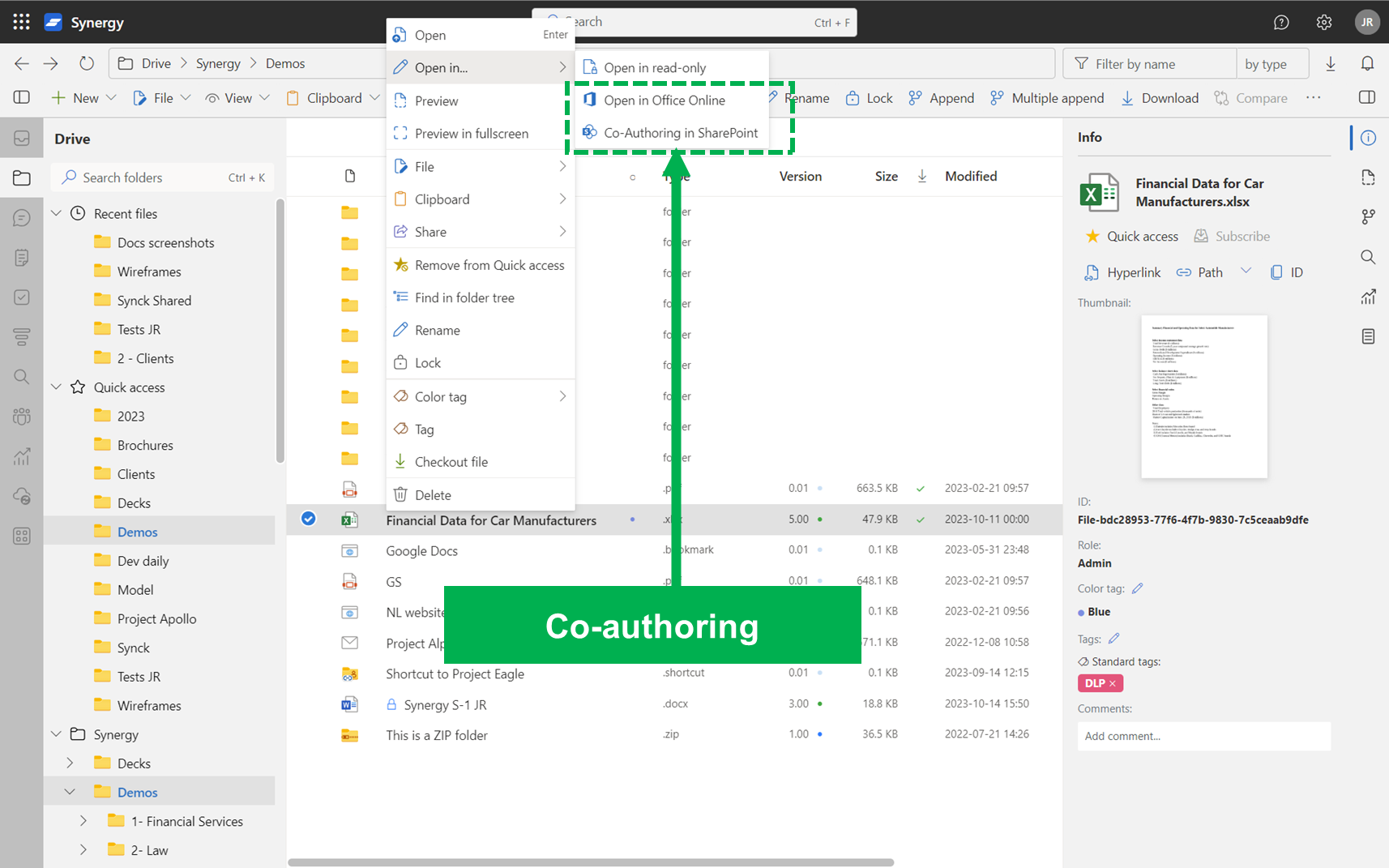Permissions & Sharing
1. What It Is
SynergyOS uses a unified permission model across all apps — Drive, Email, Notes, Tasks, Chat, and more.
You assign access at the folder level, and those rights apply everywhere.
Folders control:
- Who sees the content (visibility)
- What they can do with it (permissions)
Additionally, you can grant item-level permissions for specific cases. For example, a chat created in a shared folder is only accessible to its participants, even if others can see that the chat exists.
Users can be internal (your organization) or guests (external collaborators), each assigned a role that defines their capabilities.
2. Why It Matters
Most systems have disconnected permission models: files are in shared drives, email is just personal, notes live in a separate CRM, tasks in To Do lists, and therefore everything lives in a separate silo. SynergyOS solves this:
SynergyOS replaces that with a single, consistent model:
- ✅ One system for all content — files, tasks, emails, and more
- ✅ Share folders, not copies — avoid duplication and chaos
- ✅ Live access enforcement — links respect real-time permissions
- ✅ Audit trail ready — every action and permission change is tracked
- ✅ Item-level security — restrict access even inside a shared folder
3. How to Use It
Account Types
There are three types of users in your SynergyOS repository:
| Type | Managed By | Description |
|---|---|---|
| Admin | Your org | Full access to all content and settings via Admin Center |
| Internal User | Your org | Created by admins. No access until added to folders |
| Guest User | Your org | External collaborators (clients, partners) invited into specific folders |
Roles for Internal and Guest Users
Roles control what a user can do once they have access to a folder. Each organization can restrict which roles are available.
| Role | View | Edit | Share | Bulk Download | Notes |
|---|---|---|---|---|---|
| Admin | ✅ | ✅ | ✅ | ✅ | Full control |
| Editor | ✅ | ✅ | ✅ | ✅ | Standard collaboration |
| Restricted Editor | ✅ | ✅ | ❌ | ❌ | Can’t invite, no bulk actions |
| Viewer | ✅ | ❌ | ❌ | Some | Read-only, can print/attach |
| Previewer | ✅ (web only) | ❌ | ❌ | ❌ | Online view only |
Folder Permissions
Permissions are assigned at the folder level and inherited by all content inside.
- Inheritance: Items and subfolders inherit access from their parent folder
- Cascade: Permissions apply to all current and future subfolders
- Non-Cascade: You can also share access to a folder without cascading to subfolders
Example: Give a lawyer access to
/Clients/Acme/Contractswithout letting them see/Clients/Acme/Emails.
Item-Level Permissions
Some items, like Chats, Files, or Tasks, support item-specific sharing:
- Folder-level permissions define who sees the item exists
- But the item itself can restrict who can open or interact with it
Example: A Chat created in
/Clients/Acmeis visible to folder members, but only participants can read or write inside it.
Item-level permissions do not override folder visibility, only access to the item's contents.
Path Links
You can generate links to any item — but links don’t grant access. They only work for people who already have permission.
| Type | Behavior |
|---|---|
| Path | Opens file or folder in SynergyOS |
| Hyperlink | Same as Path, but with a friendly display name |
| Item ID | Internal reference (can be used in search or support) |
Microsoft Office Co-authoring
You can co-edit Word, Excel, and PowerPoint documents in real time — if your org has a Microsoft 365 license.
- Works with Office Online and desktop Office apps
- Supports internal users and guests
- Changes are saved automatically as a new version in SynergyOS

To use it:
- Select a document
- Choose Open with Office Online or right-click and use the Office options
This will also be explained under Version Control & Co-Authoring.
4. FAQ
Q: Can I set different permissions in each app (e.g. files vs. email)?
A: No. Permissions apply to folders and are consistent across all apps.
Q: If I share a path link, does it give access?
A: No. The link opens the file only if the recipient already has permission.
Q: What's the difference between internal and guest users?
A: Internal users are managed by your admins. Guests are invited collaborators with limited access.
Q: Can guests co-author documents?
A: Yes — as long as they’re given access and your organization has an M365 license.
Q: Can I restrict access to a single file inside a shared folder?
A: Yes. Items like Chats or sensitive Files can have their own participant list, even inside a shared folder.